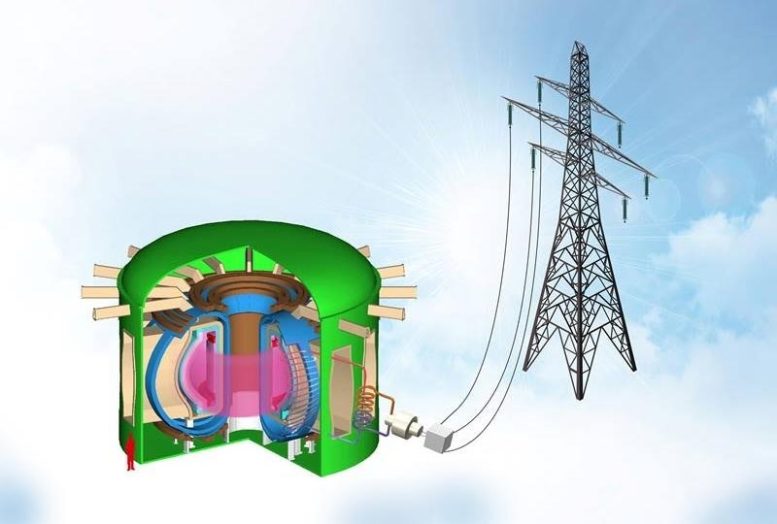The concept of the compact fusion power plant uses state-of-the-art physics to improve energy generation
from
The Compact Advanced Tokamak (CAT) is a potentially economical solution for fusion power generation that leverages advances in simulation and technology. Image Credit: Image courtesy of General Atomics. Tokamak graphic modified from F. Najmabadi et al., The ARIES-AT advanced tokamak, Advanced technology fusion power plant, Fusion Engineering Design, 80, 3-23 (2006).
Fusion power plants use magnetic fields to create a ball of gas through which electricity flows (called a
“> plasma). This creates a miniature sun that generates energy through nuclear fusion. The Compact Advanced Tokamak (CAT) concept uses cutting edge physics models to potentially improve fusion energy generation. The models show that operators of fusion systems can suppress turbulent eddies in the plasma by carefully shaping the plasma and distributing the current in the plasma. These eddies can cause heat loss. This enables operators to achieve higher pressures and fusion power with lower current. This advancement could help achieve a state where the plasma is self sustaining and driving most of its own current.
With this approach to tokamak reactors, the improved performance with reduced plasma flow reduces stress and thermal loads. This alleviates some of the engineering and materials challenges faced by fusion device designers. Higher pressure also amplifies an effect where the movement of the particles in the plasma naturally creates the required current. This significantly reduces the need for expensive power propulsion systems that consume the potential electrical power of a fusion device. It also enables a stationary “always-on” configuration. This approach results in plants that experience less stress during operation than typical pulsed approaches to fusion energy, allowing for smaller, lower cost power plants.
Last year, the Department of Energy’s Fusion Energy Sciences Advisory Committee (DOE) and the National Academies of Sciences, Engineering and Medicine published roadmaps calling for aggressive development of fusion energy in the United States. Researchers believe that achieving this goal will require developing more efficient and economical approaches to generating fusion energy than currently exist. The approach used to create the CAT concept resulted in novel reactor simulations that use the latest physical understanding of plasma to improve performance. Researchers combined cutting edge theory validated at the DIII-D National Fusion Facility with cutting edge computing technology using the Cori supercomputer at the National Energy Research Scientific Computing Center. These simulations identified a path to a concept that enables a more powerful, largely self-sufficient configuration that stores energy more efficiently than typical pulsed configurations so that it can be built at a reduced scale and cost.
Reference: “The Advanced Tokamak Path to a Compact Net Electric Fusion Pilot Plant” by RJ Buttery, JM Park, JT McClenaghan, D. Weisberg, J. Canik, J. Ferron, A. Garofalo, CT Holcomb, J. Leuer, PB Snyder and the Atom project team, March 19, 2021, nuclear fusion.
DOI: 10.1088 / 1741-4326 / abe4af
This work was supported by the Department of Energy Office of Science, Office of Fusion Energy Sciences, based on the DIII-D National Fusion Facility, a DOE Office of Science user facility, and the AToM Scientific Discovery through Advanced Computing project.



Comments are closed.